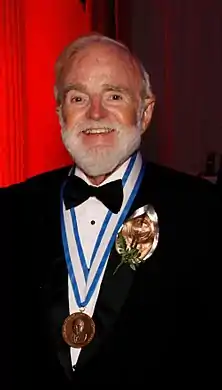Harry L. Van Trees
Harry Leslie Van Trees (born June 27, 1930) is a scientist specializing in radar, sonar, communications and signal processing.
Harry Leslie Van Trees [1] | |
|---|---|
 | |
| Born | June 27, 1930 |
| Nationality | United States |
| Alma mater | |
| Awards |
|
| Scientific career | |
| Fields | Electrical engineering, radar, sonar, and signal processing. |
| Institutions | |
| Thesis | Synthesis of Optimum Nonlinear Control Systems[2] |
| Doctoral advisor | Yuk-Wing Lee[2] |
Academic career
Van Trees attended West Point, where he graduated first in his class in 1952. [3]
After Van Trees served in the Army, he received a Master of Science in Electrical Engineering from the University of Maryland. He then attended the Massachusetts Institute of Technology (MIT) and received his Sc.D. After graduating, Van Trees joined the MIT faculty as a part of the Electrical Engineering Department.[4]
Professional contributions
While working at Massachusetts Institute of Technology (MIT) during 1968-1971, Van Trees published a three-volume series of textbooks on the detection, estimation, and modulation theory.[5][6][7] Van Trees' theory provided a "unified approach to communications, radar, and sonar."[8]
In addition to academic work, Van Trees has also assisted with the implementation of theory into practice in several Department of Defense positions. Van Trees was initially on loan to the government by MIT, he then ended up staying for a number of projects. Van Trees was the Chief Scientist of the U.S. Air Force. He also served as the Principal Deputy Assistant Secretary of Defense (C3I). Additionally, Van Trees was the Assistant Secretary of Defense for Networks and Information Integration; Command, Control, Communications and Intelligence (C3I).[8][9] From 1982-1988, Van Trees ran the Eastern Operations of M/A-Com Linkabit, a company founded by Irwin M. Jacobs and Andrew Viterbi. The M/A-Com division was sold to Science Applications International Corporation (SAIC) in 1988.
In 1987, Van Trees joined George Mason University (GMU) as a Distinguished Professor of Information Technology, and Electrical and Systems Engineering. Van Trees was also the founding director of Mason's Center of Excellence in Command, Control, Communications and Intelligence (C3I).[8][9] In 2002, Van Trees published the fourth volume of his textbook titled Optimum Array Processing. This textbook provided a more comprehensive look at optimum array processing. In 2013, Van Trees worked with Dr. Kristine L. Bell and Dr. Zhi Tian, both of GMU, to publish a second edition of the first volume.[10] This version was revised and expanded.[8]
Van Trees is also the creator of the family of Bayesian bounds. The first bound was published in 1964; and in 2007, Van Trees collaborated with Bell to publish Bayesian Bounds for Parameter Estimation and Nonlinear Filter/Tracking.[8][11][12]
Van Trees also worked with two colleagues from M/A-Com and founded CommQuest Technologies Inc.[10] CommQuest was a "developer and supplier of advanced semiconductors for wireless comms."[13] CommQuest was purchased by IBM in 1999.[14][15] Van Trees and his wife established the Harry and Diane Van Trees Electrical Engineering and Computer Science Endowment at West Point.[3]
Recent awards
In 2015, Harry Van Trees was awarded the IEEE Jack S. Kilby Signal Processing Medal. The award is presented for outstanding achievement in signal processing theory, technology, or commerce.[16] Van Trees was inducted into the National Academy of Engineering in 2015.[8][9]
Personal life
Van Trees has been married to Diane Enright Van Trees since April 25, 1953. They have seven children, 19 grandchildren, and seven great-grandchildren.[17]
References
- Harry Leslie Van Trees was elected in 2015 as a member of National Academy of Engineering in Electronics, Communication & Information Systems Engineering for contributions to detection, estimation, and modulation theory and leadership of defense communication systems.
- Harry L. Van Trees at the Mathematics Genealogy Project
- "National Academy of Engineering Member Elections." United States Military Academy West Point. Department of Electrical Engineering and Computer Science, n.d. Web. 23 Nov. 2015. http://www.usma.edu/eecs/SitePages/Home.aspx
- "Harry Van Trees." Electrical and Computer Engineering Department at George Mason University. George Mason University, n.d. Web. 23 Nov. 2015. http://bass.gmu.edu/faculty_info/van.html Archived 2004-07-07 at the Wayback Machine
- Detection, Estimation, and Modulation Theory, Part I. New York: John Wiley and Sons, 1968.
- Detection, Estimation, and Modulation Theory, Part II. New York: John Wiley and Sons, 1971.
- Detection, Estimation, and Modulation Theory, Part III. New York: John Wiley and Sons, 1971.
- "Harry L. Van Trees." - Engineering and Technology History Wiki. N.p., 8 Apr. 2015. Web. 23 Nov. 2015. http://ethw.org/Harry_L._Van_Trees
- McDonald, Michele. "Van Trees Elected to National Academy of Engineering." George Mason University News. Electrical and Computer Engineering Department, 12 Feb. 2015. Web. 23 Nov. 2015. https://ece.gmu.edu/news/van-trees-elected-national-academy-engineering-0
- "Dr Harry Van Trees Publishes New Textbook." Center of Excellence in Command Control Communications Computing and Intelligence. George Mason University, n.d. Web. 23 Nov. 2015. http://c4i.gmu.edu/2013/08/dr-harry-van-trees-publishes-new-textbook/
- Van Trees, Harry L. Detection, Estimation, and Modulation Theory, Part IV, Optimum Array Processing. New York: Wiley-Interscience, 2002. Print.
- Van Trees, Harry L., and Kristine L. Bell. Bayesian Bounds for Parameter Estimation and Nonlinear Filtering / Tracking. Piscataway, NJ: IEEE, 2007. Print.
- http://www.telecompaper.com/news/ibm-to-acquire-commquest-technologies--129969
- "IBM and CommQuest Technologies Announce Merger Agreement." IBM News Room. IBM, n.d. Web. 23 Nov. 2015. https://www-03.ibm.com/press/us/en/pressrelease/2796.wss
- "IBM to Buy CommQuest for $180 Million." Los Angeles Times, 12 Feb. 1998. Web. 23 Nov. 2015. http://articles.latimes.com/1998/feb/12/business/fi-18187
- "IEEE Jack S. Kilby Signal Processing Medal Recipients." IEEE Jack S. Kilby Signal Processing Medal Recipients. IEEE, n.d. Web. 23 Nov. 2015. http://www.ieee.org/about/awards/bios/kilby_recipients.html
- "Campaign Profiles." West Point Association of Graduates. N.p., n.d. Web. 23 Nov. 2015. http://westpointforusall.org/VanTrees.html